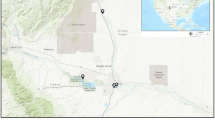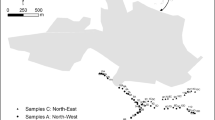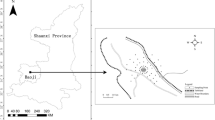Abstract
An investigation to characterize the extent and speciation of lead contamination in water, soil, and surrounding biota was conducted at a small-arms firing and skeet range in West Point, New York. Specifically, lead concentrations were examined in sediment, soil, water, plants, fish and invertebrates. There is an elevated concentration of lead in the soil and sediment up to 11,000 μg/g and 340 μg/g and also evidence of bioconcentration of the lead by the surrounding biota. Earthworms had up to 90% higher concentrations of lead while tadpoles showed 20% higher concentrations compared with their controls. Lead uptake by indigenous plants gave varying results. Two species bioconcentrated lead 20 and 55 times greater than the control plants. These differences were significant (P <0.05 level) when tested by the student’s t test. Further studies show that the total leachable lead was highest in the invertebrates and vertebrates but not in the plants.



Similar content being viewed by others
References
Barona A, Romero F (1997) Relationships among metals in the solid phase of soils and in wild plants. Water Air Soil Pollut 95:59–74
Chen M, Daroub SH, Ma LQ, Harris WG, Cao X (2002) Characterization of lead in soils of a Rifle/Pistol shooting range in central Florida, USA. Soil Sediment Contam 11:1–17
DeShields BR, Meredith RW, Griffin D, Laughlin T, Collins W (1998) The use of field methods to evaluate the toxicity of lead to plants at a small-arms firing range. Environ Toxicol Risk Assess 7:166–183
Enseco Inc. (1991) Metals digestion-soil/sediment, water. SOP no.: LM-EST-2001, Rev. 2.0
Gowdy SM, Labare MP (2004) Lead uptake by Solidago rugosa and Spirea latifolia. J Undergrad Chem Res 2:47–49
Helrich K (ed) (1990) Lead in fish: atomic absorption spectrophotometric method. Off Met Anal 15th edn., 1:257
Hui CA (2002) Lead distribution throughout soil, flora, and an invertebrate at a wetlands skeet range. J Toxicol Environ Health, Part A, 65:1093–1107
Jorgensen SS, Willems M (1987) The fate of lead in soil: the transformations of lead pellets in shooting range soil. Ambio 16(1):11–15
Lewis LA, Poppenga RJ, Davidson WR, Fischer JR, Morgan KA (2001) Lead toxicosis and trace element levels in wild birds and mammals at a firearms training facility. Arch Environ Contam Toxicol 41:208–214
Manninen S, Tanskanen N (1993) Transfer of lead from shotgun pellets to humus and three plant species in a Finnish shooting range. Arch Environ Contam Toxicol 24:410–414
Martin AC, Zim HS, Nelson AL (1951) American wild life and Plants: a Guide to Wildlife Food Habits. Dover Publications, Inc., New York, USA, pp. 269 and 418
Pankakoski E, Koivisto I, Hyvarinen H, Terhivuo J, Tahka KM (1994) Experimental accumulation of lead from soil through earthworms to common shrews. Chemosphere 29(8):1639–1649
Qian J-H, Zayed A, Zhu Y-L, Yu M (1999) Phytoaccumulation of trace elements by wetland plants: III. Uptake and accumulation of ten elements by twelve plants species. J Environ Qual 28:1448–1455
Tessier A, Campbell PGC, Bisson M (1979) Sequential extraction procedure for the speciation of particulate trace metals. Anal Chem 51:844–851
Vyas NB, Spann JW, Heinz GH, Beyer WN, Jaquette JA, Mengelkoch JM (2000) Lead poisoning of passerines at a trap and skeet range. Environ Pollut 107:159–166
World Health Organization (1972) Evaluation of mercury, lead, cadmium and the food additives amaranth, diethylpyrocarbonate, and octyl gallate, 16th Rep. Joint FAO/WHO Expert Committee on Food Additives WHO Technol Rep Serv. no. 505
Xiong Z-T (1998) Lead uptake and effects on seed germination and plant growth in a Pb hyperaccumulator Brassica pekinensis. Rupr Bull Environ Contam Toxicol 60:285–291
Acknowledgements
The authors would like to thank Dr. David Loehle and Mr. Anand Shetty for their technical assistance. This work was supported by the two departments’ student research programs.
Author information
Authors and Affiliations
Corresponding author
Rights and permissions
About this article
Cite this article
Labare, M.P., Butkus, M.A., Riegner, D. et al. Evaluation of lead movement from the abiotic to biotic at a small-arms firing range. Env Geol 46, 750–754 (2004). https://doi.org/10.1007/s00254-004-1097-x
Received:
Accepted:
Published:
Issue Date:
DOI: https://doi.org/10.1007/s00254-004-1097-x




